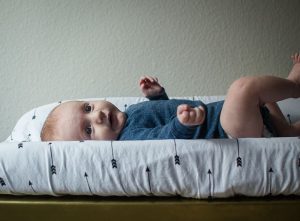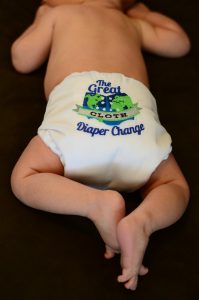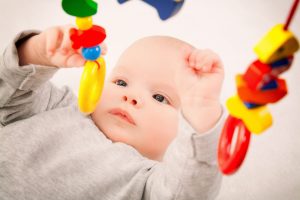While changing diapers is not your favorite task to do, it is still a big part of the baby-care package. Suppose you are a new parent who is new to this job. In that case, you might find it confusing and intimidating but trust me, once you mastered the techniques and eventually get used to nappy changing, you’ll be able to change diapers in a fast and efficient way.
Table of Contents
Setting up and Getting Ready
The most common mistake parents or babysitters make when changing diapers is not having everything they need within arms reach. Before starting, make sure that you have prepared and disinfected your changing area. Most parents use a changing table or a changing pad on the floor. We generally do not recommend changing diapers on the bed, since it could be if a problem when things get messy.
Before you begin, make sure to have the diapers with you. Other things that you should prepare, include wet wipes or warm water and a soft cloth for cleaning and wiping, also keep a cream or ointment in hand in case of rashes and irritation. It is also ideal that you prepare a change of clothes just in case things get messy. When changing your baby’s diapers, it is recommended that you have them secured or use changing straps to avoid accidents. Newborn babies may not be moving too much, but once your baby turns three months old, they can start moving and rolling. Other than maintaining cleanliness, it is also imperative that you ensure safety for your little one. 
When you are travelling or on the move, like preparing an extra set of baby bottle, you should also always prepare and bring enough set of diapers, cleansing wipes, and change of clothes too.
Know when to change your baby’s diaper
Knowing if the diaper is already soiled or dirty is easy; however, you should not rely solely on your sense of smell. There are instances that you might not able to identify, or the smell might not be strong enough. Take note that younger babies can use and go through as many as ten to fifteen diapers per day.
We suggest that you check your baby’s diapers every two hours even if it still smells clean and shows no sign of being soiled. You may also take a quick look moments after breastfeeding, bottle feeding, or mealtime. You can check your baby’s diaper by pulling the waistband or the leg area a bit and looking in if it’s dirty or super wet.
Some babies are very obvious poopers, they grunt or scrunch up their faces, and that will be your cue that you should change the diapers a few seconds after. When your baby is asleep, there will be no need for a diaper change until they wake up or tend to be very uncomfortable because of a dirty diaper.
Step by step guide
Prepare the supplies needed
First things first, get a clean diaper ready. Before starting the diaper change, always make sure to have the supplies needed ready and within reach. You wouldn’t want to be moving back and forth from the changing table to the diaper trolley, cabinet, or baby backpack and leave your baby dirty and unattended.
Also, make sure that you have prepared a safe and clean place to change your baby’s diaper. Do not forget to prepare a trash bin to throw the dirty diapers in.
Remove the soiled diaper.
After making sure that your baby is placed correctly and securely, carefully unfasten the soiled diaper. If you are unfastening a disposable diaper, simply unfasten the diaper tabs. When undoing a cloth diaper, you may have to unfasten the snaps or simply pull the Velcro.

Hold your baby’s legs up in one hand and use the other to hold the front part of the diaper down, but do not remove the diaper entirely yet. For diapers that have been just peed on, you may fold them underneath, making the clean outside part under their bottom and start cleaning. For diapers with poop, you need to quickly wipe as much as you can off your baby’s bottom first before folding the dirty diaper underneath.
Clean your baby
The next step is wiping your baby clean. Always make sure that your little one is secure and safely placed before proceeding with a thorough cleaning. Cleaning and wiping are easy, simply grab your baby’s ankles in one hand and hold their legs up and gently wipe their bottom with your other hand.
Always remember to wipe from front to back especially for baby girls to avoid infection. Be sure to clean thoroughly and get onto the creases. While making sure that every inch of your baby is clean, also remember that you should be doing it gently. Don’t wipe or rub too hard and don’t pull on the skin too much to avoid developing rashes.
Slowly slide off the dirty diaper, be careful so that your baby won’t touch it. Always dispose of soiled items properly.
Place the new and clean diaper.
Always look at the clean diaper before sliding it under your baby’s bottoms, note which part should be facing front. Slide the new diaper under and apply diaper creams or ointments before finally closing up the diaper. You would want to apply the creams with the diaper already in place under the bum to avoid smearing of creams all over the changing area.
Close and adjust the new diaper
When it comes to disposable diapers, the adhesive tapes can be easily found near the belly button area, simply remove the sticker and close up the diapers. When using cloth diapers, only use snaps or velcros, avoid using safety pins as it can be dangerous and might poke your baby.
When the diaper is all closed up, you should always check if snugly fits. It should not be too tight to avoid rashes, discomfort, and irritation. The diapers should not also be loose since it may leak, and things can get messy.
Clean and wash
Always make sure that you dispose of the dirty diapers and soiled items properly. Throw then into the non-biodegradable trash bin after shaking the bulk of poos into the toilet. Never throw a diaper or wet wipes into the toilet. For cloth diapers, also throw the bulk of poos into the toilet and initially wash them before prepping them for laundry.
After disposing of everything, make sure to do a final wiping down your baby’s legs and other body parts that might have come in contact with the soiled items. Also thoroughly clean the changing area right after every diaper change and always wash your hands and practice good hand hygiene.
Dress your baby
After changing and cleaning your baby, finish dressing them up with your favorite onesies or the most comfortable clothes they have.
Gender-specific diaper changing tips
Generally, the diaper changing procedure is similar for both girls and boys; however, there are essential tips that you might need to note.
For baby girls
Anatomically, baby girls are more prone to urinary tract infection. That’s why it is important to remember that when changing baby girls, always wipe from front to back and not vice versa also use a new wipe or the clean side of the cloth to wipe again. When changing a baby girl’s diaper, also remember to clean the vaginal area as the poop can be everywhere too.
For baby boys
The thing you should look out after when changing baby boy’s diapers is getting peed on. What you can do is cover their penis with a clean cloth or an unused diaper to avoid unwanted splashing. Also, remember to clean gently around the penis and scrotum area. When your baby is circumcised, they may need special care while they are healing. Remember to be super gentle and always follow special instructions given by the doctor.
Tips and tricks
- Never change on food serving areas, that means the kitchen or the dining area will always be a no-go zone when it comes to diaper changing. Also, avoid snacking or eating while changing diapers, I mean, who would do that right? Lol.
- Secure and ensure that your baby is intact and properly placed on the changing area with zero chance of falling.
- Gently pat instead of scrubbing when cleaning your baby’s bottoms. Baby skin is sensitive; that is why you have to be as gentle as possible to avoid irritation and rashes.
- Only use cleansing wipes that are specifically made for babies, if you opt to use soap and water also choose a soap that is gentle on baby’s skin.
- Asking help from your pediatrician is expected, do not be afraid to consult your doctor if you notice diaper rashes on your baby that doesn’t heal even after using creams and ointments and changing diaper brands.
- Aftercare is essential. Always remember to clean the changing area and properly dispose of soiled supplies.
Conclusion
Don’t panic when changing diapers! We know it can be challenging and really gross at first, but trust us, with proper practice and the right guidance, you’ll become a pro as days go by. Eventually, you will become better, faster, and more efficient in diaper-changing, and you would not even notice. We are always here to help, every step of the way!

